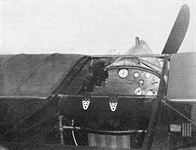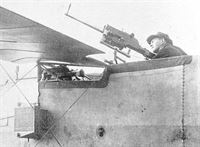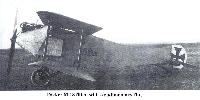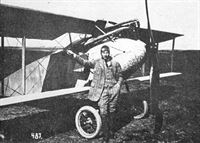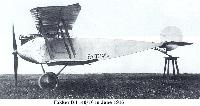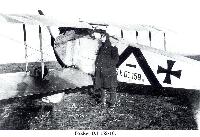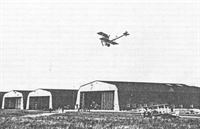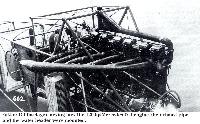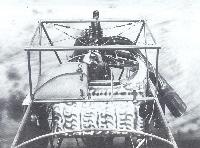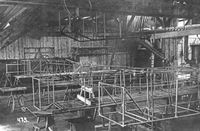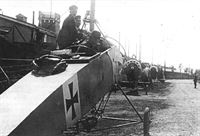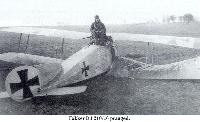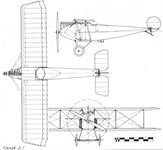
Описание
Страна: Германия
Год: 1916
Истребитель
Варианты
- Fokker - D.I / M.16 / M.18 - 1916 - Германия
- Fokker - D.IV / M.20 / M.21 - 1916 - Германия
- В.Кондратьев Самолеты первой мировой войны
- A.Weyl Fokker: The Creative Years (Putnam)
- J.Herris, J.Leckscheid Fokker Aircraft of WWI. Vol.3: Early Biplane Fighters (A Centennial Perspective on Great War Airplanes 53)
- J.Herris Fokker Aircraft of WWI. Vol.6: Foreign Service (A Centennial Perspective on Great War Airplanes 56)
- O.Thetford, P.Gray German Aircraft of the First World War (Putnam)
- W.Green, G.Swanborough The Complete Book of Fighters
- P.Grosz, G.Haddow, P.Shiemer Austro-Hungarian Army Aircraft of World War One (Flying Machines)
- E.Hauke, W.Schroeder, B.Totschinger Die Flugzeuge der k.u.k. Luftfahrtruppe und Seeflieger 1914-1918
-
J.Herris, J.Leckscheid - Fokker Aircraft of WWI. Vol.3: Early Biplane Fighters /Centennial Perspective/ (53)
Fokker D.I 159/16, Unknown unit, 1916
-
J.Herris, J.Leckscheid - Fokker Aircraft of WWI. Vol.3: Early Biplane Fighters /Centennial Perspective/ (53)
Fokker D.I 159/16 with a stylized "A" personal markings
-
J.Herris, J.Leckscheid - Fokker Aircraft of WWI. Vol.3: Early Biplane Fighters /Centennial Perspective/ (53)
Fokker D.I 168/16, Jasta 4, September 1916
-
J.Herris, J.Leckscheid - Fokker Aircraft of WWI. Vol.3: Early Biplane Fighters /Centennial Perspective/ (53)
Fokker D.I 185/16, Ltn. Erwin Bohme, Jasta 2, September 1916
-
В.Кондратьев - Самолеты первой мировой войны
"Фоккер" D.I турецких ВВС, 1917г.
-
J.Herris - Fokker Aircraft of WWI. Vol.6: Foreign Service /Centennial Perspective/ (56)
Fokker B.III 04.12 MADI, Lt. Stefan Laszlo, Flik 17
-
J.Herris - Fokker Aircraft of WWI. Vol.6: Foreign Service /Centennial Perspective/ (56)
Fokker B.III 04.15, Oblt. Franz Cserich, Flik 24
-
В.Кондратьев - Самолеты первой мировой войны
Фоккер D.I (малосерийная машина, несколько экземпляров состояло на вооружении австрийских ВВС), пилот - гауптман Р.Стоявлевич.
-
E.Hauke, W.Schroeder, B.Totschinger - Die Flugzeuge der k.u.k. Luftfahrtruppe und Seeflieger 1914-1918
Fokker D I 04.15 Raoul Stojsavljevic Flik 16 Frühjahr 1916
-
J.Herris, J.Leckscheid - Fokker Aircraft of WWI. Vol.3: Early Biplane Fighters /Centennial Perspective/ (53)
The first form of the M.16Z, with wing warping and a 160 hp Mercedes D III engine.
The M.16 (w/n 418) prototype is set up for photographic documentation at Schwerin, likely in December 1915 or January 1916. The engine cylinders are fully cowled, skids have been fitted to the lower wingtips to prevent damage in case of a slightly imperfect landing on snow-covered or frozen ground during the winter. The large side-mounted radiator shows well in these views, and the unusual application of the Iron Cross marked on a square background on the comma-shaped rudder is of interest. (Peter M. Grosz Collection/STDB) -
J.Herris, J.Leckscheid - Fokker Aircraft of WWI. Vol.3: Early Biplane Fighters /Centennial Perspective/ (53)
The M.16 (w/n 418) prototype is set up for photographic documentation at Schwerin, likely in December 1915 or January 1916. The engine cylinders are fully cowled, skids have been fitted to the lower wingtips to prevent damage in case of a slightly imperfect landing on snow-covered or frozen ground during the winter. The large side-mounted radiator shows well in these views, and the unusual application of the Iron Cross marked on a square background on the comma-shaped rudder is of interest. (Peter M. Grosz Collection/STDB)
-
J.Herris, J.Leckscheid - Fokker Aircraft of WWI. Vol.3: Early Biplane Fighters /Centennial Perspective/ (53)
Right-side view of the completed w/n 435 illustrates the engine exhaust. Also just barely visible is the works number 435 on the lower part of the rudder.
-
J.Herris, J.Leckscheid - Fokker Aircraft of WWI. Vol.3: Early Biplane Fighters /Centennial Perspective/ (53)
The Fokker M.16ZK built for Austria with the 185/200-h.p. Austro-Daimler engine.
The M16 in the definitive form in which it was evaluated by the Luftfahrttruppen of Austria-Hungary in the spring of 1916.
Still unarmed when this photo was taken, the works number 435 can be seen applied to the forward fuselage between the radiator and the forward landing gear strut. For the pilot, a full-chord cutout was designed into the upper wing. Entering the cockpit must have been somewhat awkward. No crash pylon was provided for, at least none is showing in any of the photos of the M.16 prototype duo. The aircraft was assigned military number 03.91 when it arrived in Austria. -
J.Herris - Fokker Aircraft of WWI. Vol.6: Foreign Service /Centennial Perspective/ (56)
The crankcase of the six-cylinder inline engine installed in the second M.16 prototype left visible oil stains on the bottom of the fabric-covered nose of the aircraft. One can only hope Fokker did not get too close and ruin his jacket while the photo was taken.
-
J.Herris, J.Leckscheid - Fokker Aircraft of WWI. Vol.3: Early Biplane Fighters /Centennial Perspective/ (53)
Photographed at Schwerin-Gorries around February 1916, designer Martin Kreutzer takes position in the pilot seat, with Anthony Fokker in the rear seat. Both are wearing their flying outfits, as is Austro-Hungarian Oberleutnant Hans Mandl, who was accompanied by three Officers from the Fliegerarsenal (Flars) on this visit to Schwerin. The LFT designation for M.16/II was 03.91. (Peter M. Grosz Collection/STDB)
-
P.Grosz, G.Haddow, P.Shiemer - Austro-Hungarian Army Aircraft of World War One /Flying Machines/
The freshly-painted Fokker 03.91 (M 16) upon its arrival at the Aspern test center in April 1916. The wing-tip skids prevented the tips from touching, particularly on uneven or rough airfields. The military serial number has not yet been applied, nor does armament appear to have been installed.
-
P.Grosz, G.Haddow, P.Shiemer - Austro-Hungarian Army Aircraft of World War One /Flying Machines/
The second M.16 (w/n 435) is shown here after arrival at Aspern on April 15, 1916, with Austro-Hungarian insignia applied. Military designation of 03.91 was assigned in Austrian service.
-
J.Herris - Fokker Aircraft of WWI. Vol.6: Foreign Service /Centennial Perspective/ (56)
Built for the Austro-Hungarian LFT, the second M.16 (w/n 435) is shown here during evaluation at Schwerin around March 1916. Noteworthy improvements to the design had been made by then, including the fitting of much smaller and more compact radiators to the fuselage sides, made by the Windhoff company. The nose was given a more streamlined shape by the addition of three stringers. A large oval cutout in the center of the upper wing improved downward vision, and the balanced ailerons show well in both pictures. A Morell tachometer is mounted to the forward inner strut on the left side of the aircraft, a clear indication that speed trials were being conducted at the time. This was usually done only when favorable weather conditions prevailed.(Peter M. Grosz Collection/STDB)
-
J.Herris - Fokker Aircraft of WWI. Vol.6: Foreign Service /Centennial Perspective/ (56)
Frontal view of the completed w/n 435 with pilot (most likely Fokker himself) in the cockpit illustrates the view forward offered by the cutout and streamlined shape of the forward fuselage.
-
A.Weyl - Fokker: The Creative Years /Putnam/
Fokker in the pilot’s cockpit of the M.16ZK.
-
J.Herris, J.Leckscheid - Fokker Aircraft of WWI. Vol.3: Early Biplane Fighters /Centennial Perspective/ (53)
Nose view of the first M.16 illustrating the slab-sided engine covers. For transport, the wings are mounted to tubes extending from the lower fuselage. When assembling the aircraft, the lower wings would be mounted to these tubes. Note the large radiators well visible between fuselage and wings. The sign on the sliding door on the right reads "Rauchen Verboten - No Smoking".
-
J.Herris, J.Leckscheid - Fokker Aircraft of WWI. Vol.3: Early Biplane Fighters /Centennial Perspective/ (53)
The crankcase of the six-cylinder inline engine installed in the second M.16 prototype left visible oil stains on the bottom of the nose of the aircraft.
The Factory number (435) of the M.16ZK is visible in this photograph. This has led to the erroneous belief that the aircraft had the Austrian number 04.35. -
J.Herris - Fokker Aircraft of WWI. Vol.6: Foreign Service /Centennial Perspective/ (56)
The crankcase of the six-cylinder inline engine installed in the second M.16 prototype left visible oil stains on the bottom of the fabric-covered nose of the aircraft.
-
J.Herris, J.Leckscheid - Fokker Aircraft of WWI. Vol.3: Early Biplane Fighters /Centennial Perspective/ (53)
A unique view into the cockpit and rear seat shows noteworthy details, such as the machine gun mounted on the left side, cockpit instrumentation and the small and still unblemished windscreen. It also provides a rare view at the rear of the "ear" radiators. (Peter M. Grosz Collection/STDB)
-
A.Weyl - Fokker: The Creative Years /Putnam/
The cockpits of the M.16ZK.
-
P.Grosz, G.Haddow, P.Shiemer - Austro-Hungarian Army Aircraft of World War One /Flying Machines/
Fokker mechanic Carl Henze demonstrating the flexible Schwarzlose M 16 machine gun. A forward-firing synchronized gun is mounted beside the pilot. This aircraft, the second M 16 prototype built, was sometimes referred to as the M 16/11 in Fokker records.
-
A.Weyl - Fokker: The Creative Years /Putnam/
The armament of the M.16ZK.
-
J.Herris - Fokker Aircraft of WWI. Vol.6: Foreign Service /Centennial Perspective/ (56)
A flexible Austrian Schwarzlose MG-16 is being demonstrated for the benefit of the camera by Fokker mechanic Carl Henze. A fixed Schwarzlose machine-gun was mounted offset to the left side of the airframe. The thin, unpadded leather coaming around the cockpit area shows well in this view. (Peter M. Grosz Collection/STDB)
-
J.Herris, J.Leckscheid - Fokker Aircraft of WWI. Vol.3: Early Biplane Fighters /Centennial Perspective/ (53)
The welded fuselage section of the first M.16 (supposedly w/n 418), with the Mercedes D.III 160 hp inline engine and both machine guns already fitted. For the photo, only the left-hand radiator has been fitted, allowing a look at the pilot seat and the fuel tank below it. For once, the gas bottles needed for the welding process show in the right side of the picture. (Peter M. Grosz Collection/STDB)
-
J.Herris, J.Leckscheid - Fokker Aircraft of WWI. Vol.3: Early Biplane Fighters /Centennial Perspective/ (53)
The three steel-tube stringers that gave w/n 435 a more streamlined nose were of considerably thinner diameter than the main structure tubes. These thin stringers were also provided for the bottom nose of the aircraft, resulting in a fairly complex welded steel-tube structure. The arrangement of components close to the propeller shaft are a part of the machine gun interrupter gear, which is mounted on the left side of the airframe on w/n 435. (Peter M. Grosz Collection/STDB)
-
J.Herris, J.Leckscheid - Fokker Aircraft of WWI. Vol.3: Early Biplane Fighters /Centennial Perspective/ (53)
The uncovered fuselage of w/n 435 at the Fokker experimental workshop, just after installation of the Austro-Daimler engine, which is still being held by chains from the ceiling. The fixed Schwarzlose MG-16 is already fitted. Compare these photos to the detail nose view. Other noteworthy details include the mounting of the fuel tank below the pilot seat, with the fuel tank filler neck exiting on the left side of the fuselage. The upper photo allows a look at the structure of the rhomboid-shaped rudder. (Peter M. Grosz Collection/STDB)
-
J.Herris, J.Leckscheid - Fokker Aircraft of WWI. Vol.3: Early Biplane Fighters /Centennial Perspective/ (53)
Fokker very much liked to employ his workforce or other human beings in weight tests to visualize the strength of his designs in the best possible way. Here 15 men of the workforce weight test the landing gear of M.17E (w/n 433) - note the flat tire! The fuselage of the Austro-Daimler M.16 (w/n 434) can be seen at right. (Peter M. Grosz Collection/STDB)
Другие самолёты на фотографии: Fokker D.II / M.17 - Германия - 1916
-
J.Herris, J.Leckscheid - Fokker Aircraft of WWI. Vol.3: Early Biplane Fighters /Centennial Perspective/ (53)
Complete line-up of the initial quartet of Fokker's new generation of biplane aircraft in early 1916. Seen from right to left are: M.16 w/n 435, M.16 w/n 418, M.18 w/n 434, and M.17 w/n 433.
Другие самолёты на фотографии: Fokker D.II / M.17 - Германия - 1916
-
J.Herris, J.Leckscheid - Fokker Aircraft of WWI. Vol.3: Early Biplane Fighters /Centennial Perspective/ (53)
Fokker fighter prototypes; from left the M.17E, M.16Z, and M.18E. (Peter M. Grosz Collection/STDB)
Другие самолёты на фотографии: Fokker D.II / M.17 - Германия - 1916
-
J.Herris, J.Leckscheid - Fokker Aircraft of WWI. Vol.3: Early Biplane Fighters /Centennial Perspective/ (53)
The Fokker fighter prototypes; from left the M.16Z, M.18E, and M.17E.
The small Mercedes-powered M.18E (w/n 434) pictured at centre next to the even more diminutive first M.17E (w/n 433) at right. The fact that sequential works numbers were assigned to both prototypes proves that they were built alongside, as was the earlier-mentioned M.16 prototype w/n 435. The family resemblance of the single-seaters is plainly obvious in this view. (Peter M. Grosz Collection/STDB)Другие самолёты на фотографии: Fokker D.II / M.17 - Германия - 1916
-
P.Grosz, G.Haddow, P.Shiemer - Austro-Hungarian Army Aircraft of World War One /Flying Machines/
The Aviatik 30.06, based on the Fokker M 16, is shown here on the aerodrome at Aspern. The prototype was variously referred to as the “Gassner-Aviatik,” the “Fokker Walfisch” or the “Fokker-Fischamend."
-
P.Grosz, G.Haddow, P.Shiemer - Austro-Hungarian Army Aircraft of World War One /Flying Machines/
The pilot’s position directly behind the front wing spar of 30.06 required an open center section to provide good visibility. An observer’s gun ring was not installed for flight tests.
-
P.Grosz, G.Haddow, P.Shiemer - Austro-Hungarian Army Aircraft of World War One /Flying Machines/
The fatal crash of the 30.06 on 7 May 1916 shows that the aircraft was modified with balanced elevators and a Fokker-style rudder.
-
Сайт - Pilots-and-planes /WWW/
Fokker M16E of 1915. To be historically accurate it is the Fokker M16 Karausche. The E (= Einsteilig) is a spurious designation added after WW1. You know it, there was also a two-bay Fokker M16, which got the spurious designation M16Z.
-
J.Herris, J.Leckscheid - Fokker Aircraft of WWI. Vol.3: Early Biplane Fighters /Centennial Perspective/ (53)
Engine and radiator of the M.18E. (M.16E ???) The nose panels were slab-sided with a rounded contour. In the next iteration they would be more fitted and rounded. The frame would also be modified for the new panels. (Peter M. Grosz Collection/STDB)
-
J.Herris, J.Leckscheid - Fokker Aircraft of WWI. Vol.3: Early Biplane Fighters /Centennial Perspective/ (53)
Fokker M.18E (M.16E ???) single-bay prototype. This M.18E prototype was also known as the Karausche or Carp.
-
Сайт - Pilots-and-planes /WWW/
Прототипом D I был опытный самолет М18. Его конструктивной "изюминкой" было установленное на фюзеляже верхнее крыло. На фотографии - Э. Фоккер, обычно выполнявший первый полет при испытаниях нового самолета.
Anthony Fokker in the M 18 prototype. -
J.Herris, J.Leckscheid - Fokker Aircraft of WWI. Vol.3: Early Biplane Fighters /Centennial Perspective/ (53)
The Fokker M.18E single-seat fighter prototype photographed at Schwerin in February-March 1916.
-
Сайт - Pilots-and-planes /WWW/
Fokker M 18 fitted with a rudimentary fin.
-
J.Herris, J.Leckscheid - Fokker Aircraft of WWI. Vol.3: Early Biplane Fighters /Centennial Perspective/ (53)
The works number 501 can be seen at the bottom of the rhomboid-shaped rudder in this side view. Great care has been taken to rotate the propeller into the most aesthetic position in each of these three pictures. (Peter M. Grosz Collection/STDB)
-
J.Herris, J.Leckscheid - Fokker Aircraft of WWI. Vol.3: Early Biplane Fighters /Centennial Perspective/ (53)
The rearview of w/n 501 vividly illustrates the unique sharp-pointed tail of the aircraft. This design feature proved to be unsuccessful, and on later machines, the wider, knife-edged tail known from the earlier Fokker E-types was reintroduced.
-
J.Herris, J.Leckscheid - Fokker Aircraft of WWI. Vol.3: Early Biplane Fighters /Centennial Perspective/ (53)
Two port side views of the aircraft. Note that the works number 501 has also been applied to the lower forward fuselage, below the Windhoff radiator. At this time, no other markings besides the works number have yet been applied. (Above: Peter M. Grosz Collection/STDB)
-
P.Grosz, G.Haddow, P.Shiemer - Austro-Hungarian Army Aircraft of World War One /Flying Machines/
The Fokker M 18 (w/n 501) prototype photographed at the German test center at Doberitz in the spring of 1916. It was powered by a 120 hp Mercedes engine and armed with one Spandau MG 08/15 machine gun.
-
A.Weyl - Fokker: The Creative Years /Putnam/
Fokker with the M.18Z.
-
J.Herris, J.Leckscheid - Fokker Aircraft of WWI. Vol.3: Early Biplane Fighters /Centennial Perspective/ (53)
Anthony Fokker poses with works number 501, which can be considered the first true prototype of the Fokker D.I at the airfield in Schwerin-Gorries in March 1916. At this point, the plane was unarmed, but the stains on the side of the fuselage indicate that it has already been flown. The thick side-mounted radiators were manufactured by the Windhoff Company, which also supplied the first side radiators for the early Albatros D.I and D.II fighters. The different tonality of the aircraft fabric in two different prints of photos taken within moments of each other vividly demonstrate the difficulty of interpreting orthochromatic photos. Note the small windscreen.
-
J.Herris, J.Leckscheid - Fokker Aircraft of WWI. Vol.3: Early Biplane Fighters /Centennial Perspective/ (53)
In late March/early April, celebrity visitors came to Schwerin to discuss the future development of biplane fighters with Fokker and his team. In the background, seen as second from the right, Oswald Boelcke, converses with Wilhelm Frankl. Fokker is standing on the right wheel of the M.18 prototype, while a mixed group of officials and pilots examine a plywood disc that has been fitted to the prop after firing test have been conducted. (Peter M. Grosz Collection/STDB)
-
J.Herris, J.Leckscheid - Fokker Aircraft of WWI. Vol.3: Early Biplane Fighters /Centennial Perspective/ (53)
By that time, the earlier Windhoff radiators have been replaced with larger radiators. Standing with the back to the camera, wearing a dark suit and light-colored hat, is Heinrich Lubbe, the weapons specialist at Fokker. He points out the effectiveness of the machine-gun synchronizing gear to Waldemar von Buttlar, an officer who earned his pilots license in 1912 and was now serving with the Idflieg technical examination board. Von Buttlar is holding a flying helmet and carries goggles on his cap, a clear indication that he flew the aircraft, or was about to fly it. Frankl seems to cast a somewhat skeptical look at the disc, while at the extreme right Fokker designer Martin Kreutzer is seen.
-
J.Herris, J.Leckscheid - Fokker Aircraft of WWI. Vol.3: Early Biplane Fighters /Centennial Perspective/ (53)
During their late March/early April visit, Frankl and Boelcke took the opportunity to evaluate the latest Fokker designs. These stills, taken from cine film taken during that visit, show Boelcke boarding an unidentified M.18 prototype. This aircraft was still powered by a 100 hp Mercedes D.I engine. Designer Martin Kreutzer is seen in three of these pictures.
-
J.Herris, J.Leckscheid - Fokker Aircraft of WWI. Vol.3: Early Biplane Fighters /Centennial Perspective/ (53)
Up & up! Aircraft w/n 501 is circling low over the airfield at Schwerin-Gorries, likely during one of its first test-flights in March 1916. The sharp-pointed tail shows pretty well in these views.
-
J.Herris, J.Leckscheid - Fokker Aircraft of WWI. Vol.3: Early Biplane Fighters /Centennial Perspective/ (53)
While spectators watch from the ground, the M.18 prototype is put into a low left-hand turn above the "Fokker" shed at the Schwerin-Gorries airfield. An E.III or E.IV, the last of the mid-wing monoplanes produced by Fokker, provides a symbolic contrast in the left bottom of the picture to the first Fokker biplane fighter that will go into production. (Peter M. Grosz Collection/STDB)
-
J.Herris, J.Leckscheid - Fokker Aircraft of WWI. Vol.3: Early Biplane Fighters /Centennial Perspective/ (53)
Fokker D.I 140/16. The radiators were enlarged and the later rudder was comma-shaped. (Peter M Grosz Collection/STDB)
-
J.Herris, J.Leckscheid - Fokker Aircraft of WWI. Vol.3: Early Biplane Fighters /Centennial Perspective/ (53)
Fokker designer Martin Kreutzer next to his creation, the first production Fok. D.I with Mercedes D.II and Garuda propeller, No. 140/16. He would lose his life at the controls of an M.18 on 27 June 1916.
-
J.Herris, J.Leckscheid - Fokker Aircraft of WWI. Vol.3: Early Biplane Fighters /Centennial Perspective/ (53)
Fokker D.I 140/16 under evaluation at Adlershof in June, now fitted with the ungainly tail fin. Although difficult to see, the additional drift wire connecting the nose bottom of the forward inner struts is now present. No doubt this was fitted as a result of the tests in late May/early June 1916.
-
Сайт - Pilots-and-planes /WWW/
An early production D I 140/16 in June 1916
-
J.Herris, J.Leckscheid - Fokker Aircraft of WWI. Vol.3: Early Biplane Fighters /Centennial Perspective/ (53)
Side view of factory-fresh D.I 140/16 set up for company photo documentation. The factory serial numbers and national insignia have not yet been applied. Note the glossy appearance of the wing bottom fabric. No fixed fin has been added. (Peter M. Grosz Collection/STDB)
-
A.Weyl - Fokker: The Creative Years /Putnam/
The first Fok. D.I, No. 140/16.
-
J.Herris, J.Leckscheid - Fokker Aircraft of WWI. Vol.3: Early Biplane Fighters /Centennial Perspective/ (53)
Fokker D.I 140/16.The radiators were enlarged and the later rudder was comma-shaped. (Peter M Grosz Collection/STDB)
-
Сайт - Pilots-and-planes /WWW/
A close-up view of the Fokker D.I 140/16
-
J.Herris, J.Leckscheid - Fokker Aircraft of WWI. Vol.3: Early Biplane Fighters /Centennial Perspective/ (53)
The yet-unmarked tail section of D.I 140/16, likely photographed on the same day as the previous photos of this plane. The factory works number is yet to be applied to the bottom of the rudder.
-
J.Herris, J.Leckscheid - Fokker Aircraft of WWI. Vol.3: Early Biplane Fighters /Centennial Perspective/ (53)
An early-production Fokker D.I, possibly 140/16, on its landing approach. The tall radiators seen on early-production aircraft show well from this unusual perspective.
-
Сайт - Pilots-and-planes /WWW/
Fokker D I 140/16 had wing-warping control.
-
J.Herris, J.Leckscheid - Fokker Aircraft of WWI. Vol.3: Early Biplane Fighters /Centennial Perspective/ (53)
A direct comparison of the wing-warping Fokker D.I 140/16, seen above, and the aileron-prototype D.I 141/16 below is allowed by these two photos. The balanced aileron horns of D.I 141/16 show well in the below three-quarter frontal view of the aircraft and are a reliable identification feature. At this point, both aircraft feature just the single drift wire fitted from the nose to the top of the forward inner wing struts.
-
Сайт - Pilots-and-planes /WWW/
Three-quarter rearview of D.I 141/16, the sole known aileron-controlled Fokker D.I. The aileron-controlled wings required a new wing design, and this was not completed before production of the Fokker D.I was terminated.
-
J.Herris, J.Leckscheid - Fokker Aircraft of WWI. Vol.3: Early Biplane Fighters /Centennial Perspective/ (53)
Taken in early May 1916, this photo captures the assembly of two very early D.I aircraft on the airfield at Schwerin-Gorries. These are most likely 141/16 with its aileron-wings at right, and 140/16 with warping wings next to it, both still lack the military numbers on their fuselages. The aircraft hidden by an M.17 prototype at the left of the picture appears to be another M.18 variation mounting a swept upper wing.
Другие самолёты на фотографии: Fokker D.II / M.17 - Германия - 1916
-
J.Herris, J.Leckscheid - Fokker Aircraft of WWI. Vol.3: Early Biplane Fighters /Centennial Perspective/ (53)
Wilhelm Frankl apparently paid another visit to the Fokker factory in late June or early July 1916. The aircraft seen behind him is an unidentified unarmed M.18 prototype fitted with "M" shaped cabane struts not seen in other M.18 photos. Later, this strut arrangement was adopted for the production Fokker D.IV. This may be the swept upper wing machine seen earlier on the airfield at Schwerin with other M.17 and M.18 trial aircraft. The Pour le Merite worn by Frankl has been retouched into the photo; it was actually awarded to him on 8 August 1916.
-
J.Herris, J.Leckscheid - Fokker Aircraft of WWI. Vol.3: Early Biplane Fighters /Centennial Perspective/ (53)
An example of a very early-production aircraft fitted with the tail fin, D.I 143/16 is captured here with its tail set up on a trestle.
-
J.Herris, J.Leckscheid - Fokker Aircraft of WWI. Vol.3: Early Biplane Fighters /Centennial Perspective/ (53)
Factory-fresh D.I 145/16 is seen here at an unidentified location. The new fighter, likely one of the very first examples to reach the front, already attracts a certain amount of attention.
-
J.Herris, J.Leckscheid - Fokker Aircraft of WWI. Vol.3: Early Biplane Fighters /Centennial Perspective/ (53)
Fokker D.I 150/16 was belly-landed by Obltn. Otto Dessloch at KEK Ensisheim on 20, August 1916. The factory works number "702" can barely be made out on the rear interplane struts. Even though this was a fairly new aircraft, the lower longeron borders are already heavily stained.
-
J.Herris, J.Leckscheid - Fokker Aircraft of WWI. Vol.3: Early Biplane Fighters /Centennial Perspective/ (53)
Jagdstaffel 1 was the first Jasta to become operational, resuming frontline duties on 22 August 1916 from Bertincourt, moving to Bertigny just two days later. Here Leutnant Gustav Leffers, one of the star pilots of the unit, can be seen in front of the wingtip of D.I 151/16 (works number 703). The aircraft was shipped from Schwerin on 8 August 1916.
-
J.Herris, J.Leckscheid - Fokker Aircraft of WWI. Vol.3: Early Biplane Fighters /Centennial Perspective/ (53)
A pair of Jasta 1 Fokker D.Is in front of their tent hangars. Jasta 1 operated a substantial number of D.Is during their first three months of frontline service, being credited with a total of 29 victories during this period. How many of these were claimed on the D.I remains unknown. However, on 4 December, Vzfw. Karl Ehrnthaller crashed to his death flying Fokker D.I 175/16. Wing failure occurred during a frontline flight without an enemy in sight, and the early Fokker D-types were quickly grounded as a consequence.
-
Сайт - Pilots-and-planes /WWW/
Fokker D.I 157/16 on the Adlershof airfield.
-
Сайт - Pilots-and-planes /WWW/
Fokker D.I 159/16 is a rare example of a D.I carrying a personal marking. A large stylized letter "A" has been marked on the fuselage side, carefully applied in order to leave the "F" of the military number intact. The shadow of the photographer and his camera can be seen in the left bottom of the picture.
-
J.Herris, J.Leckscheid - Fokker Aircraft of WWI. Vol.3: Early Biplane Fighters /Centennial Perspective/ (53)
The last two digits of the military number of this D.I are conveniently covered by a strut, but this may in fact be D.I 153/16 or 163/16. It certainly is an early-production example featuring the tall radiator, while it lacks any upper-wing camouflage. It has been suggested that the aircraft flew with Jasta 26, a unit that was only formed between mid-December 1916 and mid-January 1917 in Darmstadt. By then, the D.I had largely been relegated to training duties.
-
J.Herris - Halberstadt Aircraft of WWI. Volume 2: CL.IV-CLS.I & Fighters /Centennial Perspective/ (45)
Many of the Kampfeinsitzerkommandos and the first Jagdstaffeln operated a mixed selection of aircraft types in the late summer of 1916. In the center of this view, a disassembled Fokker E.II/III can be seen, as well as four Halberstadt D-type fighters and two Fokker D.Is, with D.I 168/16 seen at right. Pictured here is the newly-formed Jagdstaffel 4 at Roupy airfield, with its characteristic barn hangar seen at right. Initial members of the Staffel included Oblt. Buddecke, Oblt. Berthold, Ltn. Bernert, Vzfw. Frankl, Ltn. Fugner and Vzfw. Clausnitzer. The six biplane fighters in the photo may well have been the initial equipment for these six men when the unit was formed on 25 August.
Другие самолёты на фотографии: Fokker E.I / E.II / E.III / M.14 - Германия - 1914Halberstadt D.II/D.III - Германия - 1916
-
J.Herris, J.Leckscheid - Fokker Aircraft of WWI. Vol.3: Early Biplane Fighters /Centennial Perspective/ (53)
Lacking its airscrew, Fokker D.I 168/16 is not ready for immediate use. It also lacks the tail fin, and it seems that a dark border has been painted along the edge of the lower wing, while no factory-applied camouflage is in evidence. The aircraft has been described as "the Boelcke plane" according to some sources, but the upper photo on this page proves it served with Jasta 4 for a time.
-
J.Herris, J.Leckscheid - Fokker Aircraft of WWI. Vol.3: Early Biplane Fighters /Centennial Perspective/ (53)
Fokker D.I 184/16 was operated by Jasta 1 and supposedly was the personal mount of Leutnant Kurt Wintgens. Note the unusually wide gap between the "DI" and "184/16" marked on the fuselages sides. Available photographs suggest that this was the last production D.I to befitted with the earlier "tall" version of the radiators. In terms of numerical sequence, this is the first aircraft documented to have the factory-applied two color upper surfaces camouflage. Note the fuselage stringer.
-
J.Herris, J.Leckscheid - Fokker Aircraft of WWI. Vol.3: Early Biplane Fighters /Centennial Perspective/ (53)
Leutnant Erwin Bohme, Jagdstaffel 2, poses next to Fokker D.I 185/16 at Velu airfield in early September 1916. This may have been the first D.I mounting the smaller radiator, and the two-tone upper surface factory camouflage scheme is in evidence on wings and fuselage decking.
-
J.Herris, J.Leckscheid - Fokker Aircraft of WWI. Vol.3: Early Biplane Fighters /Centennial Perspective/ (53)
Showing very severe stains along the fuselage fabric, the military number of this D.I can only be deciphered partially, but it may read 187/16. The aircraft is armed with an LMG 08 machinegun, and an illegible line of text has been applied to the tail fin. It also mounts the smaller radiators, which topped out well below the exhaust.
-
J.Herris, J.Leckscheid - Fokker Aircraft of WWI. Vol.3: Early Biplane Fighters /Centennial Perspective/ (53)
Fokker D.I 207/16 operated on the Eastern Front and is pictured here on a snow-covered airfield in Galicia, during the winter of 1916/17. The Fokker works number "842" has been marked on the rear inner strut.
-
J.Herris, J.Leckscheid - Fokker Aircraft of WWI. Vol.3: Early Biplane Fighters /Centennial Perspective/ (53)
A rare example of a factory-refurbished machine is Fokker D.I 208/16 which is seen here serving with the BeobachterSchule Coln (observer school Cologne) in September 1917. The horizontal fuselage stringer shows very prominently from this perspective, and the tail fin has been removed. Two-tone camouflage has been applied to the fuselage sides during refurbishment, and the style of application of the military number is different from D.I 207/16 seen above - note the different stencils used to apply the number "2" on both aircraft. The one used to apply "208/16" was still in use in April 1918 when the first Fokker D.VIIs were completed in Schwerin.
-
M.Dusing - German Aviation Industry in WWI. Volume 1 /Centennial Perspective/ (84)
Один из серийных "фоккеров" D.I. В отличие от большинства ранних истребителей Фоккера, эта машина имеет развитый киль.
Another aircraft serving with Jagdstaffel 1 was Fokker D.I 216/16. The works number 861 has been marked at the bottom of the rudder and the forward lower fuselage, just behind the radiator. On the lower wing, the two-color camouflage scheme can barely be made out from this perspective. This was a late-production aircraft mounting the small radiator. -
J.Herris, J.Leckscheid - Fokker Aircraft of WWI. Vol.3: Early Biplane Fighters /Centennial Perspective/ (53)
Naval Fokker D.I LF219 shows off its factory-applied camouflage pattern. This was only applied to the upper surfaces on a number of D.Is, and consisted of one color that is rendered as very light, while the other one appears fairly darken orthochromatic film. Note that the upper wing cross is applied onto a white square background, while the fuselage and rudder crosses are applied directly onto the plain doped fabric. Compare the fuselage crosses applied onto the plain linen fuselage and rudder of the D.I to the white cross background in used on the Fokker E.IV in the background.
Другие самолёты на фотографии: Fokker E.IV / M.15 - Германия - 1915
-
J.Herris, J.Leckscheid - Fokker Aircraft of WWI. Vol.3: Early Biplane Fighters /Centennial Perspective/ (53)
Another view of the same aircraft illustrates how lighting conditions and the angle from which a photo was taken affect the tonality of colors in photos. Here the two upper wing colors appear much closer in tonality than in the previous photo.
-
J.Herris, J.Leckscheid - Fokker Aircraft of WWI. Vol.3: Early Biplane Fighters /Centennial Perspective/ (53)
Two newly-arrived Naval Fokker D.Is. The glossy fabric applied to the wing bottom reflects the sunlight on D.I LF220 at left. Both aircraft are early-production models, fitted with the taller radiator that almost touches the bottom of the exhaust.
-
J.Herris, J.Leckscheid - Fokker Aircraft of WWI. Vol.3: Early Biplane Fighters /Centennial Perspective/ (53)
Lack of armament on this unidentified aircraft and the two-seaters in the background indicate that it served with a training unit, possibly an FEA. Visible details indicate that this was an aircraft in the 142/16 - 183/16 range. The early tall radiator, which almost touches the bottom of the exhaust, and the crescent-shaped valve opening on the inner wheel cover show well in this photo.
-
O.Thetford, P.Gray - German Aircraft of the First World War /Putnam/
Unavoidably, a wing strut prevents complete identification of the military number of this Jasta 16 D.I photographed at Ensisheim airfield.
-
J.Herris, J.Leckscheid - Fokker Aircraft of WWI. Vol.3: Early Biplane Fighters /Centennial Perspective/ (53)
Compared to the bare appearance of D.I 140/16, this late-production machine, most likely from the final 1900/16 - 1909/16 batch, displays some noticeable differences. The small radiator was only seen on late-production D.Is, and the aircraft is painted in a full camouflage scheme which has even been applied to the metal nose section. D.Is from the final production batch again lacked the tail fin. Lack of armament and the two-seaters in the background suggest the plane served with a training unit.
-
J.Herris, J.Leckscheid - Fokker Aircraft of WWI. Vol.3: Early Biplane Fighters /Centennial Perspective/ (53)
Lineup of three late-production Jasta 14 D.Is at Buhl, featuring a metal cover in front of the forward cylinder. No doubt this modification was added as the colder season approached. A detail of considerable interest is the fact that no trace of the fuselage military number can be seen on the fully-visible D.I. At least a part of it should be visible next to the right arm of the mechanic. This strongly suggest that the fuselage of this aircraft was overpainted, possibly in light blue. A fourth D.I can be seen at right, also lacking the military number, and mostly hidden by an Albatros D.II. This type offered considerably better overall performance compared to the Fokker, and Jasta 14 converted to the Albatros as deliveries allowed during November and December 1916.
Другие самолёты на фотографии: Albatros D.I/D.II - Германия - 1916
-
J.Herris, J.Leckscheid - Fokker Aircraft of WWI. Vol.3: Early Biplane Fighters /Centennial Perspective/ (53)
Obltn. Rudolf Berthold, commander of Jasta 14, and two of his fellow pilots oversee a Fokker D.I of their unit being serviced at Buhl in October/November 1916. Again, no trace of the fuselage military number can be seen on the left side of the aircraft, but it is impossible to say with certainty if this is the same aircraft seen in the center of the photo above or a different one.
-
J.Herris, J.Leckscheid - Fokker Aircraft of WWI. Vol.3: Early Biplane Fighters /Centennial Perspective/ (53)
Ltn. Otto Kissenberth, at right, speaking to Ltn. Fritz Grunzweig, a fellow Jasta 16 pilot. The aircraft behind them is a D.I from the final production batch numbered 1900/16 - 1909/16. The man on the left is apparently preparing to take the photo shown below.
-
J.Herris, J.Leckscheid - Fokker Aircraft of WWI. Vol.3: Early Biplane Fighters /Centennial Perspective/ (53)
Ltn. Fritz Grunzweig and Otto Kissenberth pictured within moments of the previous photo. Kissenberth obscures most of the fourth digit of the military number, but the fraction left indicates that this may well be 1901/16.
-
J.Herris, J.Leckscheid - Fokker Aircraft of WWI. Vol.3: Early Biplane Fighters /Centennial Perspective/ (53)
Otto Kissenberth is working on the nose section of a Jasta 16 Fokker D.I. The satin sheen of the factory-applied wing camouflage is of interest. From this perspective, the much smaller size of the late-production radiators shows particularly well.
-
J.Herris, J.Leckscheid - Fokker Aircraft of WWI. Vol.3: Early Biplane Fighters /Centennial Perspective/ (53)
Once again Otto Kissenberth is present, this time gleaming back from the cockpit of what is believed to be his personal D.I. A small semi-circular cutout has been added to the windscreen of his aircraft.
-
J.Herris, J.Leckscheid - Fokker Aircraft of WWI. Vol.3: Early Biplane Fighters /Centennial Perspective/ (53)
Leutnant Hans Auer poses with his new Fokker D.I at Ensisheim. This was also also a machine from the production batch numbered 1900/16 - 1909/16, of which several were supplied to Jasta 16, but again the last digit of the number is illegible. Even though both photos are severely blemished, the lack of stains and immaculate finish of the plane indicate the photos were taken soon after it reached Jasta 16.
-
J.Herris, J.Leckscheid - Fokker Aircraft of WWI. Vol.3: Early Biplane Fighters /Centennial Perspective/ (53)
A late-production D.I, photographed at an unknown location, attracts the attention of a large number of spectators. This is possibly an aircraft from the final production batch (1900/16 - 1909/16), featuring the small radiator, horizontal fuselage side stringers, and factory-applied camouflage on the fuselage sides.
-
J.Herris, J.Leckscheid - Fokker Aircraft of WWI. Vol.3: Early Biplane Fighters /Centennial Perspective/ (53)
Jagdstaffel 14 resumed operations at the airfield at Buhl in early October 1916. This unit also received numerous Fokker D.Is as their initial equipment, and here a late example, most likely from the final batch often aircraft, is seen loaded up behind a truck on a rainy day in front of the hangar at Buhl airfield. Unfortunately, the photo is not clear enough to make out the Fokker works number applied to the bottom of the rudder.
-
J.Herris - Fokker Aircraft of WWI. Vol.6: Foreign Service /Centennial Perspective/ (56)
Fokker B.III (M.18) 04.11 (work number 501). This aircraft was sent to Fluggeschwader 1 on 24 February 1917. (Peter M. Grosz collection/STDB)
-
J.Herris, J.Leckscheid - Fokker Aircraft of WWI. Vol.3: Early Biplane Fighters /Centennial Perspective/ (53)
The Austro-Hungarian LFT evaluated a Fokker M.18 fitted with ailerons and the early Windhoff radiators. At this point, the aircraft was unarmed, and for some reason smaller-diameter wheels have been fitted. The fuselage cross was marked closer to the cockpit than on the Fliegertruppe aircraft.
-
J.Herris - Fokker Aircraft of WWI. Vol.6: Foreign Service /Centennial Perspective/ (56)
The Fokker M 18 (w/n 501) prototype as delivered to Aspern in April 1916. It now has the characteristic button-shaped rudder and was unarmed. The assigned designation was 03.92 (later 04.11).
Fokker B.III (M.18) 04.11 (work number 501), before application of the serial number. The aircraft can be identified by its ailerons; the rest of the batch used wing-warping. -
J.Herris - Fokker Aircraft of WWI. Vol.6: Foreign Service /Centennial Perspective/ (56)
Fokker B.III 04.11 without propeller in front of a hangar. (Peter M. Grosz collection/STDB)
-
J.Herris - Fokker Aircraft of WWI. Vol.6: Foreign Service /Centennial Perspective/ (56)
Fokker B.III (M.18) 04.11 (work number 501). It appears the new serial number, 04.11, was applied after scraping off the old serial, 03.92. This aircraft was sent to Fluggeschwader 1 on 24 February 1917. (Peter M. Grosz collection/STDB)
-
E.Hauke, W.Schroeder, B.Totschinger - Die Flugzeuge der k.u.k. Luftfahrtruppe und Seeflieger 1914-1918
An Austrian Fok. D.I with horn-balanced ailerons.
Fokker B.III, Flugzeugnummer 04.11 (ex 03/92) -
J.Herris - Fokker Aircraft of WWI. Vol.6: Foreign Service /Centennial Perspective/ (56)
Fokker B.III 04.11 being moved to the right spot on the field to take off. (Peter M. Grosz collection/STDB)
-
P.Grosz, G.Haddow, P.Shiemer - Austro-Hungarian Army Aircraft of World War One /Flying Machines/
The Fokker M 18 (w/n 501) prototype, now re-designated B.III 04.11, and a production B.III (04.27) were assigned to Fluggeschwader I when it was established in December 1916. The B.III 04.11 was used as an unarmed trainer through February 1917 at Divacca.
-
J.Herris - Fokker Aircraft of WWI. Vol.6: Foreign Service /Centennial Perspective/ (56)
Fokker B.III 04.11 in flight. (Peter M. Grosz collection/STDB)
-
J.Herris - Fokker Aircraft of WWI. Vol.6: Foreign Service /Centennial Perspective/ (56)
Fokker B.III 04.12 (work number 712) was accepted as a D.I in Schwerin on 28 August 1916 and was sent to Austria in October 1916. Armed and named Madi, it is shown in service with Flik 17 and flown by Lt. Stefan Laszlo. (Peter M. Grosz collection/STDB)
-
J.Herris - Fokker Aircraft of WWI. Vol.6: Foreign Service /Centennial Perspective/ (56)
This view of Fokker B.III 04.12 shows that its Schwarzlose machine gun was mounted off center to the right above the upper wing. (Peter M. Grosz collection/STDB)
-
J.Herris - Fokker Aircraft of WWI. Vol.6: Foreign Service /Centennial Perspective/ (56)
This view of Fokker B.III 04.13 with fixed fin for greater stability. (Peter M. Grosz collection/STDB)
-
J.Herris - Fokker Aircraft of WWI. Vol.6: Foreign Service /Centennial Perspective/ (56)
Fokker B.III 04.15 serving at Karnten airfield. (Peter M. Grosz collection/STDB)
-
E.Hauke, W.Schroeder, B.Totschinger - Die Flugzeuge der k.u.k. Luftfahrtruppe und Seeflieger 1914-1918
Fokker B.III, Flugzeugnummer 04.15, Fliegerkompanie 24, Flugfeld Pergine
-
J.Davilla - Italian Aviation in the First World War. Vol.1: Operations /Centennial Perspective/ (73)
Fokker B.III 04.15 serving at Flik 24 at Pergine airfield in winter.
-
J.Herris - Fokker Aircraft of WWI. Vol.6: Foreign Service /Centennial Perspective/ (56)
Hauptmann Raoul Stojsavljevic of Flik 16 with Fokker B.III 04.15 (w/n 715). Armament consisted of a Schwarzlose machine-gun mounted over the right center-section struts, angled to fire upwards at 15-degrees to clear the propeller arc. A few B.III were similarly armed with a center-mounted Spandau machine gun.
Fokker B.III 04.15, work number 715, with Oblt. Franz Cserich, Flik 24, Pergine. -
J.Davilla - Italian Aviation in the First World War. Vol.1: Operations /Centennial Perspective/ (73)
Fokker B.lll 04.16 at the airfield Seebach near Villach in the winter of 1916/17. Feld. Funk achieved an aerial victory over an Italian Caproni bomber on 25.5.1917 while flying a Brandenburg D.I. (Peter M. Grosz collection/STDB)
-
J.Herris - Fokker Aircraft of WWI. Vol.6: Foreign Service /Centennial Perspective/ (56)
Fokker B.III 04.16, Flik 16, armed with a centrally-mounted Schwarzlose firing over the propeller arc. (Peter M. Grosz collection/STDB)
-
J.Herris - Fokker Aircraft of WWI. Vol.6: Foreign Service /Centennial Perspective/ (56)
Fokker B.III 04.17 was unarmed.
-
J.Herris - Fokker Aircraft of WWI. Vol.6: Foreign Service /Centennial Perspective/ (56)
Unarmed Fokker B.III 04.21. (Peter M. Grosz collection/STDB)
-
J.Herris - Fokker Aircraft of WWI. Vol.6: Foreign Service /Centennial Perspective/ (56)
Unarmed Fokker B.III 04.21. (Peter M. Grosz collection/STDB)
-
J.Herris - Fokker Aircraft of WWI. Vol.6: Foreign Service /Centennial Perspective/ (56)
An unarmed Fokker B.III 04.22 of the Fliegeroffiziersschule in Wiener-Neustadt. Production Fokker B.III biplanes were fitted with a large tail fin for added stability. Aircraft beginning with 04.18 had an extra longeron along the fuselage center line. It features wing-warping and a fixed fin.
-
A.Weyl - Fokker: The Creative Years /Putnam/
Fok. D.I in Austrian markings. This aircraft has a fin and warping wings.
-
J.Herris - Fokker Aircraft of WWI. Vol.6: Foreign Service /Centennial Perspective/ (56)
Unarmed Fokker B.III 04.22. (Peter M. Grosz collection/STDB)
-
J.Herris - Fokker Aircraft of WWI. Vol.6: Foreign Service /Centennial Perspective/ (56)
Unarmed Fokker B.III 04.22 landing at Wiener Neustadt airfield. A Brandenburg C.I is at right. (Peter M. Grosz collection/STDB)
Другие самолёты на фотографии: Hansa-Brandenburg C.I - Германия - 1915
-
J.Herris - Fokker Aircraft of WWI. Vol.6: Foreign Service /Centennial Perspective/ (56)
Unarmed Fokker B.III 04.23 in flight. (Peter M. Grosz collection/STDB)
-
J.Herris - Fokker Aircraft of WWI. Vol.6: Foreign Service /Centennial Perspective/ (56)
Unarmed Fokker B.III 04.23 in its hangar. (Peter M. Grosz collection/STDB)
-
J.Herris - Fokker Aircraft of WWI. Vol.6: Foreign Service /Centennial Perspective/ (56)
A crash of Fokker B.III 04.23; it was repaired. (Peter M. Grosz collection/STDB)
-
J.Herris - Fokker Aircraft of WWI. Vol.6: Foreign Service /Centennial Perspective/ (56)
Unarmed Fokker B.III 04.26. (Peter M. Grosz collection/STDB)
-
J.Herris - Fokker Aircraft of WWI. Vol.6: Foreign Service /Centennial Perspective/ (56)
Fokker B.III 04.27 on its nose after a rough landing. (Peter M. Grosz collection/STDB)
-
J.Herris - Fokker Aircraft of WWI. Vol.6: Foreign Service /Centennial Perspective/ (56)
Hptm. Raoul Stoisavljevic, Flik 16, in Fokker B.III 04.2X work number 801 armed with a Schwarzlose firing over the propeller arc. (Peter M. Grosz collection/STDB)
-
P.Grosz, G.Haddow, P.Shiemer - Austro-Hungarian Army Aircraft of World War One /Flying Machines/
Installation of the 100 hp Mercedes engine in the Fokker B.III(MAG) 04.31. The MAG work number “1” is painted on the lower fuselage in front of the radiator.
-
J.Herris - Fokker Aircraft of WWI. Vol.6: Foreign Service /Centennial Perspective/ (56)
Unarmed Fokker B.III 04.XX with heavily-lagged coolant and intake pipes. (Peter M. Grosz collection/STDB)
-
J.Herris - Fokker Aircraft of WWI. Vol.6: Foreign Service /Centennial Perspective/ (56)
Unarmed Fokker B.III 04.XX. (Peter M. Grosz collection/STDB)
-
J.Herris - Fokker Aircraft of WWI. Vol.6: Foreign Service /Centennial Perspective/ (56)
The Fokker B.III(MAG) 04.31 at Aspern in November 1916. This machine was flown as an unarmed single-seat trainer with Flek 6.
-
P.Grosz, G.Haddow, P.Shiemer - Austro-Hungarian Army Aircraft of World War One /Flying Machines/
Fokker B.III(MAG) 04.31 was virtually a carbon copy of the Fokker D.II (M 18). One positive MAG identification feature is the extension of the rear center-section struts to serve as a turn-over guard.
-
Сайт - Pilots-and-planes /WWW/
Fokker D.I fuselage showing how the 120-hp Mercedes D.II engine, the exhaust pipe and the water header were mounted.
-
J.Herris, J.Leckscheid - Fokker Aircraft of WWI. Vol.3: Early Biplane Fighters /Centennial Perspective/ (53)
Engine installation in the Fokker D.I was not exactly user friendly. As is evidenced by these two photos, the Mercedes engine could not be removed from the completed airframe without surgery to at least some of the welded struts.
-
J.Herris, J.Leckscheid - Fokker Aircraft of WWI. Vol.3: Early Biplane Fighters /Centennial Perspective/ (53)
A partially-stripped Fokker D.I fuselage outside the factory building at Schwerin. This view vividly illustrates which of the forward fuselage steel tubes had to be removed in order to be able to remove the Mercedes engine. Very likely this lack of engine accessibility was one of the factors why only small batches of the D.I were ordered.
-
Сайт - Pilots-and-planes /WWW/
An under-construction view of the forward fuselage illustrates the box-like structure of the upper wing center-section strut arrangement, complete with bracing wires and turnbuckles.
-
J.Herris, J.Leckscheid - Fokker Aircraft of WWI. Vol.3: Early Biplane Fighters /Centennial Perspective/ (53)
A glimpse into the D.I fuselage from above allows a look at the simple cockpit layout. The Bosch starter magneto can be seen in the upper right cockpit corner, thanks to the empty machine gun mount. The fuel pressure control switch is mounted to the right cockpit side complete with fuel pressure gauge, and the "M.G." marked machine-gun trigger can be seen on the control column.
-
J.Herris, J.Scott - Fokker Aircraft of WWI. Vol.2: Eindeckers /Centennial Perspective/ (52)
A rare glimpse into the fuselage assembly hall at Schwerin. Nearest to the camera is an upside-down Fokker E-type fuselage, with another laying on the starboard side next to it. Behind that is a Fokker M.18 fuselage, note that the cabane struts are an integral part of the welded fuselage structure. Numerous steel-tubes cut to the proper length can be seen in the picture.
In the foreground are three (including one hanging from the ceiling) M.14 frames that lack the steel tube framing for mounting a machine gun. Presumably these are from the last batch of Fok. E.II Schuleinsitzers. Behind them are the frames for a late Fok. E.IV, a D.I, and another of indeterminate type. (Peter M. Grosz collection/STDB)Другие самолёты на фотографии: Fokker E.I / E.II / E.III / M.14 - Германия - 1914Fokker E.IV / M.15 - Германия - 1915
-
J.Herris, J.Leckscheid - Fokker Aircraft of WWI. Vol.3: Early Biplane Fighters /Centennial Perspective/ (53)
Four Fokker M.18 welded steel-frame fuselage structures can be seen in the left foreground of this picture, followed by three E-type fuselage frames. Behind that, another three M.18 fuselage frames await the horizontal engine mounting steel-tube to be welded into position. Note the method of stacking completed E-type wings against the wall in the left background of the photo. (Peter M. Grosz/STDB)
Другие самолёты на фотографии: Fokker E.I / E.II / E.III / M.14 - Германия - 1914
-
J.Herris, J.Leckscheid - Fokker Aircraft of WWI. Vol.3: Early Biplane Fighters /Centennial Perspective/ (53)
Sixteen Fokker D.I fuselages can be seen under manufacture side by side in this view, the one at the far end has already received its fabric cover. A single completed Fokker E.IV fuselage positioned near the gate faces the camera, and seven seemingly completed E.IV fuselages are positioned in the left half of the assembly hall.
Другие самолёты на фотографии: Fokker E.IV / M.15 - Германия - 1915
-
J.Herris, J.Leckscheid - Fokker Aircraft of WWI. Vol.3: Early Biplane Fighters /Centennial Perspective/ (53)
The common method of conducting load tests at the factory was to attach fabric bags filled with a prescribed load of sand to the components that were to be tested. In these views fuselages are being load tested.
-
J.Herris, J.Leckscheid - Fokker Aircraft of WWI. Vol.3: Early Biplane Fighters /Centennial Perspective/ (53)
Load tests are being conducted on the retro-fitted tail fin in June 1916 with the help of a "sandbox". This method was likely chosen in order to simulate a more even weight distribution, in the hope of replicating the forces exacted on this component in flight in a more realistic way.
-
J.Herris, J.Leckscheid - Fokker Aircraft of WWI. Vol.3: Early Biplane Fighters /Centennial Perspective/ (53)
Static tests are being conducted on the wing structure of the first M.18E (w/n 434). The wing ribs were of identical design to those of the M.17E (w/n 433).
-
J.Herris, J.Leckscheid - Fokker Aircraft of WWI. Vol.3: Early Biplane Fighters /Centennial Perspective/ (53)
A wild mix of Fokker single-seaters is ready to be shipped to the front in mid-August. Photographed behind the Fokker factory at Hintenhof 43 in Schwerin, seen at left in this view area Fokker E.II followed by one D.I and seven Fokker D.II fighters. An engineless E.III, returned to the factory from the front, completes the lineup at left. Note the bright appearance of the D.I and D.II fabric compared to the E.III wing fabric. Seen at right are two D.Is (the second one an LF- marked Naval aircraft), a D.II, another D.I and an E.IV. This is Fokker E.IV 641/15 minus wings. A better view of this plane is available in the next photo.
Другие самолёты на фотографии: Fokker D.II / M.17 - Германия - 1916Fokker E.I / E.II / E.III / M.14 - Германия - 1914Fokker E.IV / M.15 - Германия - 1915
-
J.Herris, J.Leckscheid - Fokker Aircraft of WWI. Vol.3: Early Biplane Fighters /Centennial Perspective/ (53)
The same group of aircraft photographed from the other end of the road. Fokker E.IV 641/15, seen at left, was shipped from Schwerin to the front for a second time on 18 August 1916, after being refurbished at the Fokker factory. The battered, engineless E.III is seen at right, note the worn appearance of the upper wing cross. The E.IV and several of the D.Is in these two photos still await their wings to be stacked next to their fuselages for transport.
Другие самолёты на фотографии: Fokker D.II / M.17 - Германия - 1916Fokker E.I / E.II / E.III / M.14 - Германия - 1914Fokker E.IV / M.15 - Германия - 1915
-
J.Herris, J.Scott - Fokker Aircraft of WWI. Vol.2: Eindeckers /Centennial Perspective/ (52)
Fokker E.IV 641/15 (w/n 478) receives final adjustments before being sent on its way from Schwerin on 22 April 1916. Facing it are another E.IV, a Fokker D.I, and a Fokker E.III. (Peter M. Grosz collection/STDB)
Другие самолёты на фотографии: Fokker E.I / E.II / E.III / M.14 - Германия - 1914Fokker E.IV / M.15 - Германия - 1915
-
Сайт - Pilots-and-planes /WWW/
Fokker D.I 210/16 pranged.
-
J.Herris, J.Leckscheid - Fokker Aircraft of WWI. Vol.3: Early Biplane Fighters /Centennial Perspective/ (53)
Fokker D.I 1907/16 was crashed by Ltn. Ludwig Hanstein, Jasta 16, in the winter 1916/17. This was the third-to-last Fokker D.I to be produced, production ended with 1909/16.
-
J.Herris, J.Leckscheid - Fokker Aircraft of WWI. Vol.3: Early Biplane Fighters /Centennial Perspective/ (53)
While the right wings were completely crushed during the forced landing, the steel tube fuselage remained reasonably intact. The fuel tank filler neck opening in the metal turtledeck behind the cockpit can be seen well here.
-
J.Herris, J.Leckscheid - Fokker Aircraft of WWI. Vol.3: Early Biplane Fighters /Centennial Perspective/ (53)
Taxpayers' money wasted. The central staging area of the Schwerin-Gorries airfield became something of a morgue for disused Fokker airframes. The fuselages of around 40 Fokker Eindeckers E.III and E.IV and early D-Types are piled up to await disposition in the winter of 1916/17. All engines have been removed. Whenever possible, these were returned to their respective manufacturers or overhaul facilites in order to enjoy a second life in another airframe. Several D.I and D.II aircraft, identified by the upper wing center sections welded to the fuselages, can be seen. Dead center is E.III 222/16.
Другие самолёты на фотографии: Fokker D.II / M.17 - Германия - 1916Fokker E.I / E.II / E.III / M.14 - Германия - 1914Fokker E.IV / M.15 - Германия - 1915
-
J.Herris, J.Leckscheid - Fokker Aircraft of WWI. Vol.3: Early Biplane Fighters /Centennial Perspective/ (53)
Fokker M.16 Single-Bay Prototype
-
J.Herris, J.Leckscheid - Fokker Aircraft of WWI. Vol.3: Early Biplane Fighters /Centennial Perspective/ (53)
Fokker M.16 First Two-Bay Prototype
-
J.Herris, J.Leckscheid - Fokker Aircraft of WWI. Vol.3: Early Biplane Fighters /Centennial Perspective/ (53)
Fokker M.16 Final Two-Bay Prototype
-
W.Green, G.Swanborough - The Complete Book of Fighters
The M16 in the definitive form in which it was evaluated by the Luftfahrttruppen of Austria-Hungary in the spring of 1916.
-
J.Herris, J.Leckscheid - Fokker Aircraft of WWI. Vol.3: Early Biplane Fighters /Centennial Perspective/ (53)
Fokker M.18 First Prototype
-
J.Herris, J.Leckscheid - Fokker Aircraft of WWI. Vol.3: Early Biplane Fighters /Centennial Perspective/ (53)
Fokker M.18 Modified Prototype
-
J.Herris, J.Leckscheid - Fokker Aircraft of WWI. Vol.3: Early Biplane Fighters /Centennial Perspective/ (53)
Fokker M.18 Production Prototype / D.I
-
W.Green, G.Swanborough - The Complete Book of Fighters
A general arrangement drawing of the standard production two-bay DI issued to the Fliegertruppen.
-
A.Weyl - Fokker: The Creative Years /Putnam/
Fokker D.I
-
P.Grosz, G.Haddow, P.Shiemer - Austro-Hungarian Army Aircraft of World War One /Flying Machines/
Fokker B.III Series 04.1
В.Кондратьев Самолеты первой мировой войны
"ФОККЕР" D.I/D.IV / FOKKER D.I/D.IV
Первый истребитель Фоккера бипланной схемы - "Фоккер" D.I появился в июне 1916 г. Фактическим создателем машины был летчик и инженер Мартин Кройцер, погибший при испытании ее прототипа с фабричным обозначением M.18.
Самолет представлял собой двухстоечный биплан смешанной конструкции с полотняной обшивкой. Конструкция фюзеляжа и оперения идентична "Фоккеру" E.IV, но на некоторых машинах, кроме руля поворота, монтировали еще и киль. Крылья деревянные, двухлонжеронные с мягкой задней кромкой из проволоки. Элероны отсутствовали, а управление по крену, как и у монопланов Фоккера, осуществлялось перекосом крыльев ("гошированием").
Двигатель - рядный "Мерседес" D.II водяного охлаждения мощностью 120 л.с. Радиаторы укреплены по бортам фюзеляжа. Вооружение - один синхронный пулемет LMG 08.
Летные данные машины оказались весьма посредственными, поэтому сделали всего 25 экземпляров, восемь из которых отправили в Турцию. Остальные поступили во 2-ю истребительную эскадрилью (Jasta 2), вызвав негативные оценки ее пилотов.
<...>
ЛЕТНО-ТЕХНИЧЕСКИЕ ХАРАКТЕРИСТИКИ
D.I D.IV
Размах, м 9,05 9,70
Длина, м 6,3 6,3
Площадь крыльев, м2 20,0 21,0
Сухой вес, кг 463 606
Взлетный вес, кг 671 840
Скорость макс, км/ч 145 160
Время набора высоты
1000 м, мин. 3,5 3,0
Потолок, м 4300 5000
Описание:





























